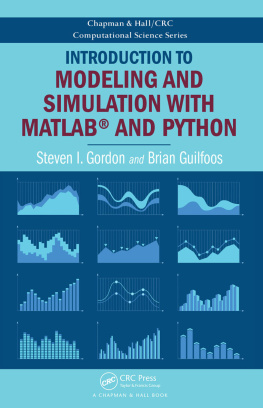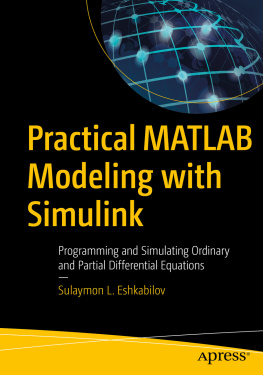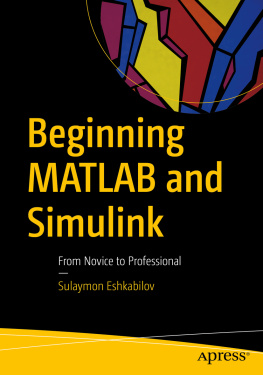Steven I. Gordon - Introduction to Modeling and Simulation with MATLAB® and Python (Chapman & Hall/CRC Computational Science)
Here you can read online Steven I. Gordon - Introduction to Modeling and Simulation with MATLAB® and Python (Chapman & Hall/CRC Computational Science) full text of the book (entire story) in english for free. Download pdf and epub, get meaning, cover and reviews about this ebook. year: 2017, publisher: Chapman and Hall/CRC, genre: Romance novel. Description of the work, (preface) as well as reviews are available. Best literature library LitArk.com created for fans of good reading and offers a wide selection of genres:
Romance novel
Science fiction
Adventure
Detective
Science
History
Home and family
Prose
Art
Politics
Computer
Non-fiction
Religion
Business
Children
Humor
Choose a favorite category and find really read worthwhile books. Enjoy immersion in the world of imagination, feel the emotions of the characters or learn something new for yourself, make an fascinating discovery.
- Book:Introduction to Modeling and Simulation with MATLAB® and Python (Chapman & Hall/CRC Computational Science)
- Author:
- Publisher:Chapman and Hall/CRC
- Genre:
- Year:2017
- Rating:4 / 5
- Favourites:Add to favourites
- Your mark:
Introduction to Modeling and Simulation with MATLAB® and Python (Chapman & Hall/CRC Computational Science): summary, description and annotation
We offer to read an annotation, description, summary or preface (depends on what the author of the book "Introduction to Modeling and Simulation with MATLAB® and Python (Chapman & Hall/CRC Computational Science)" wrote himself). If you haven't found the necessary information about the book — write in the comments, we will try to find it.
Introduction to Modeling and Simulation with MATLAB and Python is intended for students and professionals in science, social science, and engineering that wish to learn the principles of computer modeling, as well as basic programming skills. The book content focuses on meeting a set of basic modeling and simulation competencies that were developed as part of several National Science Foundation grants. Even though computer science students are much more expert programmers, they are not often given the opportunity to see how those skills are being applied to solve complex science and engineering problems and may also not be aware of the libraries used by scientists to create those models.
The book interleaves chapters on modeling concepts and related exercises with programming concepts and exercises. The authors start with an introduction to modeling and its importance to current practices in the sciences and engineering. They introduce each of the programming environments and the syntax used to represent variables and compute mathematical equations and functions. As students gain more programming expertise, the authors return to modeling concepts, providing starting code for a variety of exercises where students add additional code to solve the problem and provide an analysis of the outcomes. In this way, the book builds both modeling and programming expertise with a just-in-time approach so that by the end of the book, students can take on relatively simple modeling example on their own.
Each chapter is supplemented with references to additional reading, tutorials, and exercises that guide students to additional help and allows them to practice both their programming and analytical modeling skills. In addition, each of the programming related chapters is divided into two parts one for MATLAB and one for Python. In these chapters, the authors also refer to additional online tutorials that students can use if they are having difficulty with any of the topics.
The book culminates with a set of final project exercise suggestions that incorporate both the modeling and programming skills provided in the rest of the volume. Those projects could be undertaken by individuals or small groups of students.
The companion website at http://www.intromodeling.com provides updates to instructions when there are substantial changes in software versions, as well as electronic copies of exercises and the related code. The website also offers a space where people can suggest additional projects they are willing to share as well as comments on the existing projects and exercises throughout the book. Solutions and lecture notes will also be available for qualifying instructors.
Steven I. Gordon: author's other books
Who wrote Introduction to Modeling and Simulation with MATLAB® and Python (Chapman & Hall/CRC Computational Science)? Find out the surname, the name of the author of the book and a list of all author's works by series.










